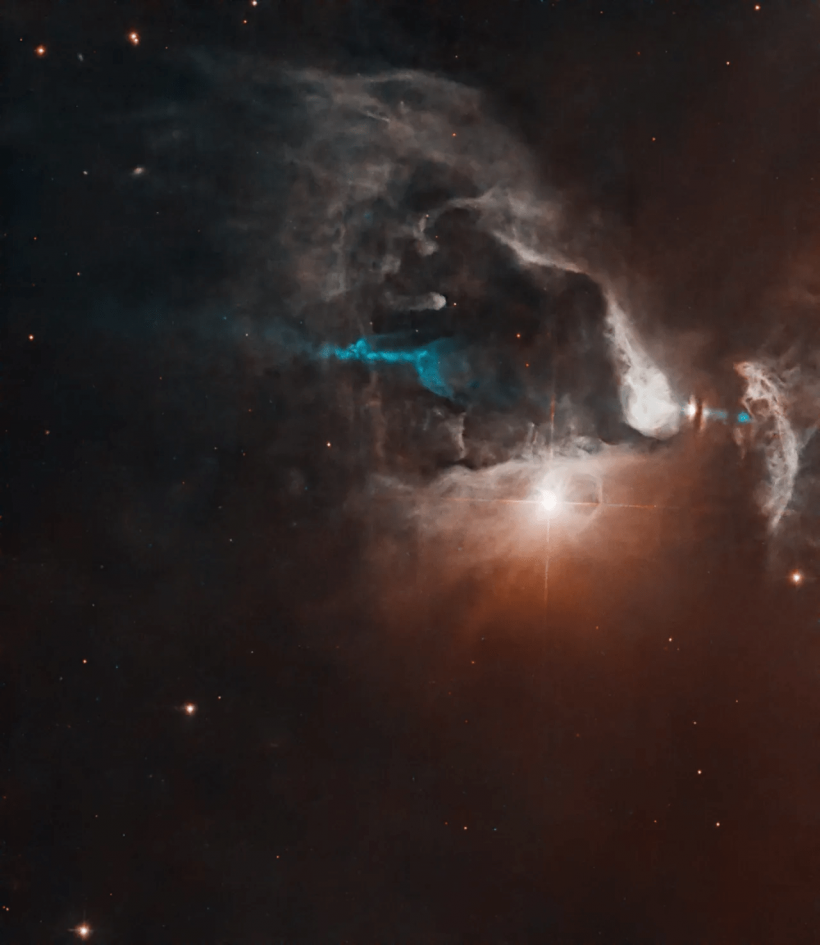NASA's Hubble Space Telescope has captured a captivating cosmic light show featuring jets emerging from a newly forming star, traversing through space, and piercing a radiant nebula's luminous gas and dust.

(Photo : NASA, ESA, and K. Stapelfeldt (NASA JPL); Image Processing: Gladys Kober (NASA/Catholic University of America))
Newly Forming Star Showcases a Cosmic Lightshow
The focal point of this cosmic spectacle is FS Tau, a multi-star system comprising FS Tau A and FS Tau B, nestled within the ethereal glow of a stellar nursery. FS Tau A, resembling a bright star-like entity at the image's core, shares space with FS Tau B, also known as Haro 6-5B, positioned toward the right amidst a shroud of dark dust.
At a mere 2.8 million years old, FS Tau is considered a youthful system in astronomical terms. This contrasts sharply with the venerable age of our Sun, estimated at 4.6 billion years, according to NASA.
FS Tau B, the younger sibling, represents a protostar enveloped in a protoplanetary disk—a conglomeration of dust and gas remnants from its formation phase, destined to coalesce into planetary bodies over time.
According to NASA, the prominent dust lane is nearly perpendicular to our line of sight and serves as a boundary between the illuminated surfaces of the disk.
In its evolutionary journey, FS Tau B is transitioning into a T Tauri star, a class of young variable stars undergoing the initial stages of nuclear fusion akin to our Sun. Protostars like FS Tau B emanate heat energy as they condense from gas clouds and accrete material from surrounding debris, causing fluctuations in brightness over time.
Meanwhile, FS Tau A exists as a binary T Tauri system, featuring two stars in mutual orbit around each other.
NASA notes that protostars are renowned for expelling energetic streams of material known as jets, a phenomenon vividly displayed by FS Tau B. This protostar showcases an intriguingly asymmetric, double-sided jet, manifesting as a striking blue feature. The jet's irregular shape suggests variations in mass expulsion rates from the protostar.
Furthermore, FS Tau B is classified as a Herbig-Haro object. It is formed when its ionized gas jets collide with adjacent gas and dust clouds at high velocities, generating luminous nebulosities.
Situated within the Taurus-Auriga region, approximately 450 light-years away, FS Tau resides amidst a constellation of dark molecular clouds teeming with nascent and adolescent stars.
This celestial neighborhood has long intrigued astronomers due to its prolific star-forming activity. This activity has made it a focal point for Hubble's investigations into edge-on dust disks surrounding young stellar entities.
Read Also: NASA Hubble Space Telescope Sees 2 Doomed Stars Creating a Pretty Cosmic Necklace
Lonely Brown Dwarfs
In related news, Hubble has recently revealed a poignant tale of celestial solitude: Aging brown dwarfs, once part of binary systems, that are growing increasingly lonely.
Researchers utilizing Hubble have found this loneliness among the lowest-mass and coldest brown dwarfs, suggesting that these binary partners quickly part ways.
This phenomenon implies that the gravitational bond between binary dwarfs weakens over time, leading them to drift apart within a few hundred million years under the gravitational influence of passing stars.
Learn more about this story here.
Related Article: NASA's Hubble Space Telescope Captures Stunning Image of a Dwarf Galaxy Under Pressure










